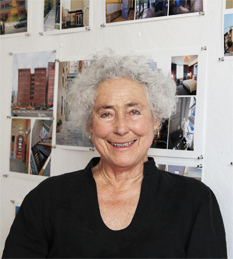Judith Edelman facts for kids
Judith Deena Edelman (born September 23, 1923 – died October 4, 2014) was an amazing American architect. She designed many different buildings in New York City with her company, Edelman Sultan Knox Wood/Architects. Judith was a strong supporter of women's rights, especially for women working in architecture. She even led the first special group for women at the American Institute of Architects.
Contents
Early Life and Education
Judith Edelman was born Judith Hochberg in Brooklyn, New York, in 1923. Her parents had moved there from Eastern Europe. From a young age, Judith was interested in architecture. She decided to become an architect after visiting an architectural office when she was in high school.
She studied at several universities, including Connecticut College and New York University. In 1946, she earned her degree in architecture from Columbia University.
Her Career as an Architect
After finishing college, Judith found it hard to get a job. Many employers told her they would not hire women. She worked for a short time designing mental hospitals. Later, she was hired by an architect named Huson Jackson in Greenwich Village.
In 1960, Judith started her own company with her husband, Harold Edelman, and Stanley Salzman. The company was first called Edelman and Salzman Architects. It later became known as Edelman Sultan Knox Wood/Architects.
Fighting for Women in Architecture
Judith Edelman was a strong voice for women architects. She believed women should be part of the American Institute of Architects (AIA), even though it was mostly men. In 1972, she became the first woman elected to a leadership role in the AIA's New York chapter.
That same year, she started the Alliance of Women in Architecture. This group worked to help women architects succeed. In 1973, she helped write a plan for the AIA. It asked the organization to change and support women more, especially with the rise of the feminist movement.
At a big AIA meeting in 1974, Judith shared some important facts. She pointed out that only 1.2 percent of all registered architects in America were women. She said that only coal mining and steel work had fewer women. After her speech, she was asked to lead the AIA's first special group focused on women. Some people at the AIA even called her "Dragon Lady" because she was so determined.
Judith's work also inspired a children's book. In 1974, Gloria and Esther Goldreich wrote What Can She Be? An Architect, which was about her.
Important Building Projects
With her company, Judith Edelman worked on many projects in New York City. She designed a lot of affordable housing, which helps people find homes they can afford. One of these projects was Phelps House, finished in 1983. It was a housing complex with a community center for older people.
In the 1960s, she worked on a unique project. She helped turn nine old brownstone houses on the Upper West Side into one large building. She made sure to keep the beautiful outside of the houses. This building is now called 9G Cooperative Apartments.
Her designs won many awards from groups like the AIA and the Municipal Art Society. In 1990, she and her husband won the Andrew J. Thomas Pioneer in Housing award. This award recognized their important work in housing.
Personal Life
Judith Edelman married Harold Edelman in 1947. They had two sons, Marc and Joshua. They also had eight grandchildren. Judith passed away on October 4, 2014, from a heart attack.


